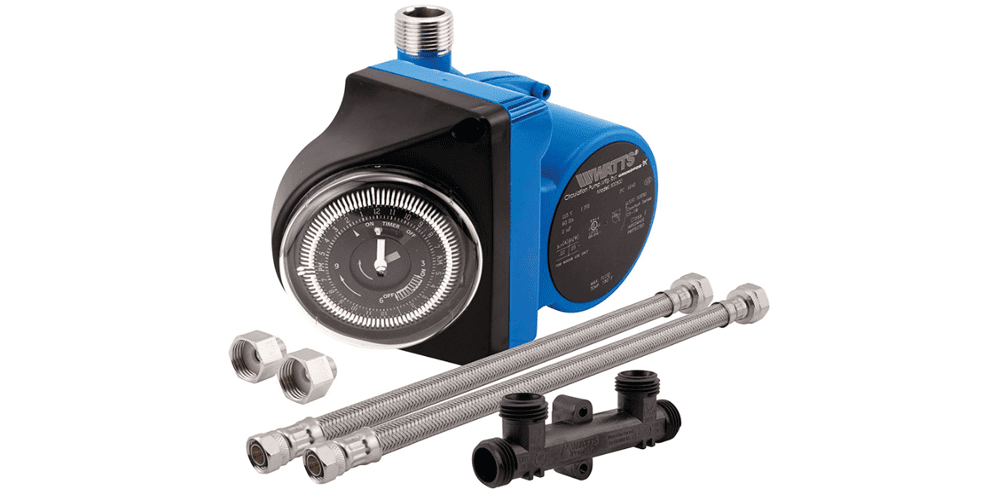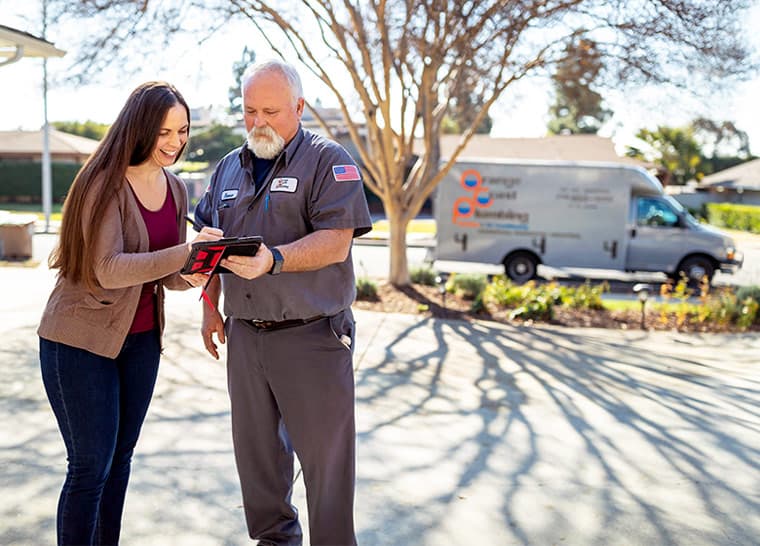You turn on the shower and wait.
And wait.
And wait.
And when you step into the stream, frigid water hits you like a glacial melt. What gives?
In a large home, hot water may travel through 50 feet or more of piping from the water heater to the shower, the kitchen sink, or wherever else it’s needed. And while you’re waiting, all that cold water ahead of it goes down the drain and into the municipal sewer system.
If you think there should be a better setup, there is. You may be a candidate for it.
What’s a Hot Water Recirculation System?
A hot water recirculation system moves heated water around your plumbing so that it arrives at the tap in a fraction of the time it would with a conventional system.
At the heart of it is a recirculation pump installed on your water heater. It pumps heated water from the heater directly to plumbing fixtures. When the water in your pipes begins to cool, the pump kicks in and sends it back to the water heater to be reheated and recirculated.
The system includes a bypass valve, allowing you to control when the pump turns on and how much hot water goes into your plumbing. You can turn off the recirculation and save energy when you’re away from home.
Active vs Passive Hot Water Recirculation Systems
Most recirculation systems use a pump to force water through the hot water supply pipe.
Passive recirculation is a more energy-efficient approach. It relies on natural convection and thermal siphoning. Warm water rises from the water heater; cold water replaces it at the lowest point of the plumbing. This creates a looping effect in which water circulates without mechanical input.
Passive systems cost more to install but require less maintenance. There are no moving parts to break down. They can save thousands of dollars over their lifetime compared to active recirculation with a continuously running pump.
Another benefit is that passive systems provide near-instant hot water. That’s because they rely on natural thermal convection rather than pumps that must be turned on manually or remotely triggered by electronic sensors.
Passive hot water recirculation systems require additional piping to work. An extra pipe runs warm water back to the heater to complete the circuit in some configurations. In other systems, warm water crosses over to the cold water pipes to return to the hot water tank.
The Pros & Cons of Hot Water Recirculation
Comfort and convenience are the clear benefits of hot water recirculation systems. Near-instant hot water is a luxury you may appreciate on a cold January morning.
On the downside, there are more efficient paths to near-instant hot water — tankless water heaters, for example — that don’t require added pipes or pumps.
The Pros
- Quicker access to hot water: You don’t have to wait for cold water to travel from the basement, garage, or attic, where the water heater is installed.
- Money savings: Because you waste less heating up cold water each time it’s needed, you can save on utility bills over time.
- Water conservation: Less water goes down the drain while you wait for hot water.
The Cons
- Upfront Cost: Installing a recirculation system is more expensive than insulating pipes or a tankless heater.
- Maintenance: Any pump will eventually need maintenance, repairs, or replacement.
- Not always cost-effective: A recirculation system may not make financial sense in an older home with short plumbing runs from the water heater to fixtures.
Hot Water Recirculation vs Instant Water Heaters
Hot water recirculation and tankless water heaters are two different methods of providing near-instant hot water.
Hot water recirculation systems keep hot water circulating through the plumbing lines of a building, so that hot water is immediately available at every fixture or appliance that requires it. This is done by installing a recirculating pump and a dedicated return line, which allows hot water to circulate continuously through the plumbing system.
Tankless water heaters, on the other hand, heat water on demand, rather than storing hot water in a tank. This means that there is no standby heat loss, and hot water is always available when you need it.
Hot water recirculation systems are generally more expensive to install and maintain than tankless water heaters, but they can provide immediate hot water at every fixture in the building. Tankless water heaters, on the other hand, are generally more energy-efficient than hot water recirculation systems, and they can provide hot water on demand without the need for a dedicated return line. However, they may not be able to provide hot water to multiple fixtures at once.
Both hot water recirculation systems and tankless water heaters have their pros and cons, and the best option for a building will depend on a variety of factors, such as the size of the building, the number of fixtures that requiring hot water, the energy efficiency goals of the building owner, and the budget.
Who Should Consider a Hot Water Recirculation System?
A recirculation system will add a small value to your home. But convenience is the only compelling reason to install one.
In California, there’s one notable exception. If you live in an area prone to droughts, where water use is closely monitored and restricted, a recirculation system can dramatically lower water consumption for a family.
Who Should Not Consider a Hot Water Recirculation System?
If you’re building a new home, your best option is to work with your plumber and architect to design a passive water system that quickly and evenly distributes hot water.
An old house with short hot water runs might not benefit from a recirculation system. Insulated pipe is often enough to cut “wait time” for hot water.
And if cost is your primary concern, there are, as we mentioned, cheaper options like tankless water heaters.
Still Not Sure?
Call us at Orange Coast Plumbing to discuss your options. All consultations are free!
We’ll let you know what makes the most sense for your home, budget, and lifestyle: tankless heater, insulated pipes, hot water recirculation system, or a combination of two or more technologies.
FAQ: Hot Water Circulation Systems
Q: How does a hot water circulation system work?
A: The system continuously circulates hot water throughout the home’s plumbing, ensuring hot water is readily available at all taps. It can work on a timer or be demand-driven, activated by a switch or motion sensor.
Q: What are the main benefits of a hot water circulation system?
A: Benefits include immediate access to hot water, reduced water waste, lower water bills, and increased convenience and comfort in the home.
Q: Are there significant drawbacks to using a hot water circulation system?
A: Drawbacks might include the initial installation cost, increased energy to keep water hot, and potential added wear to the water heater and plumbing over time.
Q: Is a hot water circulation system energy-efficient?
A: While these systems use additional energy to circulate the water, models with timers or on-demand controls can minimize energy consumption, making them more efficient and environmentally friendly.
Q: Can a hot water circulation system be retrofitted in an existing home?
A: Hot water circulation systems can be retrofitted in most existing homes. However, the complexity and installation cost can vary according to the home’s plumbing layout and the type of system selected.
Q: How long does installing a hot water circulation system take?
A: Installation times vary widely, from a few hours for simple, retrofitted systems to a day or more for comprehensive installations in larger homes or systems integrated during construction.
Q: What maintenance does a hot water circulation system need?
A: Regular maintenance can include checking the pump operation, ensuring the timer or sensors are functioning correctly, and occasionally flushing the system to remove buildup or debris.
Q: Can installing a hot water circulation system increase my home’s value?
A: Yes, a hot water circulation system can improve a home’s energy efficiency and provide the convenience of instant hot water, making it more appealing to potential buyers.
Q: Are there different types of hot water circulation systems?
A: There are two main types: full recirculating systems that connect to the water heater and fixtures and under-sink systems that serve individual faucets or areas of the home.
Q: Is it possible to run the system only during certain times of the day?
A: Systems with timers can be programmed to run only when hot water demand is highest, such as mornings and evenings, saving energy and reducing operating costs.
Q: How does a demand-controlled hot water circulation system work?
A: A demand-controlled system triggered by a button or motion sensor activates the pump when hot water is needed. This minimizes energy and water waste by circulating hot water only when required.


